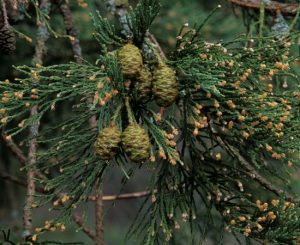Pinus wallichiana
This variety of pine is native to India, Bhutan, Nepal, northern Pakistan. These trees are found in a wide range of areas from eastern Afghanistan, Pakistan, India, Nepal, Bhutan and towards Yunnan in South west China. Pinus wallichiana is called as Bhutan Pine or Himalayan Blue Pine.

Taxonomy
| Kingdom: | Plantae |
| Division: | Pinophyta |
| Class: | Pinopsida |
| Order: | Pinales |
| Family: | Pinaceae |
| Genus: | Pinus |
| Subgenus: | Strobus |
| Species: | wallichiana |
Identification
These trees can be identified by the following charecteristics,
Needles
The leaves are in the form of needles and the needles are about 15 to 20 centimetres long. The needles appear in bundles of 5. The needles appear to be hanging from the branches rather than being erect as seen in other pine trees.

Bark
The bark of the young trees would be mostly reddish brown. But the bark gets thick and slate-grey coloured. The bark will also be shallowly fissured in old trees. The bark shown here is of an old tree with moss and lichen grown in the fissures.

Cones
The cones of Pinus wallichiana are generally long and slender. The cones vary in length from 16 to 32 cm. They are borne in the branches in bunches of 2 to 3 cones. The cones appear generally in the months of April to June. The seeds are 5 to 6 mm long with 20 to 30 mm wings.
Economic Importance
The timber of these trees are considered of high quality and are used for local carpentry. The wood is generally resinous and it is durable. The wood is also useful in making tea-boxes. The timber is also a good firewood. It burns emitting a pungent smoke as the wood is resinous.







